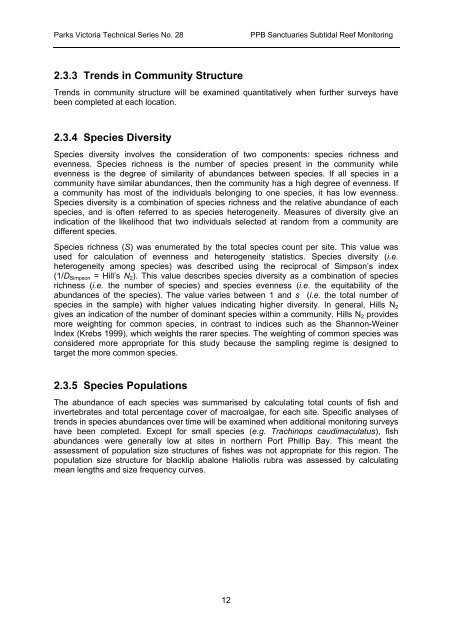Victorian Subtidal Reef Monitoring Program - Parks Victoria
Victorian Subtidal Reef Monitoring Program - Parks Victoria
Victorian Subtidal Reef Monitoring Program - Parks Victoria
Create successful ePaper yourself
Turn your PDF publications into a flip-book with our unique Google optimized e-Paper software.
<strong>Parks</strong> <strong>Victoria</strong> Technical Series No. 28PPB Sanctuaries <strong>Subtidal</strong> <strong>Reef</strong> <strong>Monitoring</strong>2.3.3 Trends in Community StructureTrends in community structure will be examined quantitatively when further surveys havebeen completed at each location.2.3.4 Species DiversitySpecies diversity involves the consideration of two components: species richness andevenness. Species richness is the number of species present in the community whileevenness is the degree of similarity of abundances between species. If all species in acommunity have similar abundances, then the community has a high degree of evenness. Ifa community has most of the individuals belonging to one species, it has low evenness.Species diversity is a combination of species richness and the relative abundance of eachspecies, and is often referred to as species heterogeneity. Measures of diversity give anindication of the likelihood that two individuals selected at random from a community aredifferent species.Species richness (S) was enumerated by the total species count per site. This value wasused for calculation of evenness and heterogeneity statistics. Species diversity (i.e.heterogeneity among species) was described using the reciprocal of Simpson’s index(1/D Simpson = Hill’s N 2 ). This value describes species diversity as a combination of speciesrichness (i.e. the number of species) and species evenness (i.e. the equitability of theabundances of the species). The value varies between 1 and s (i.e. the total number ofspecies in the sample) with higher values indicating higher diversity. In general, Hills N 2gives an indication of the number of dominant species within a community. Hills N 2 providesmore weighting for common species, in contrast to indices such as the Shannon-WeinerIndex (Krebs 1999), which weights the rarer species. The weighting of common species wasconsidered more appropriate for this study because the sampling regime is designed totarget the more common species.2.3.5 Species PopulationsThe abundance of each species was summarised by calculating total counts of fish andinvertebrates and total percentage cover of macroalgae, for each site. Specific analyses oftrends in species abundances over time will be examined when additional monitoring surveyshave been completed. Except for small species (e.g. Trachinops caudimaculatus), fishabundances were generally low at sites in northern Port Phillip Bay. This meant theassessment of population size structures of fishes was not appropriate for this region. Thepopulation size structure for blacklip abalone Haliotis rubra was assessed by calculatingmean lengths and size frequency curves.12
















